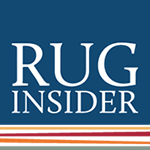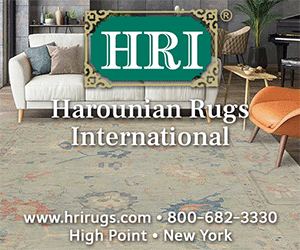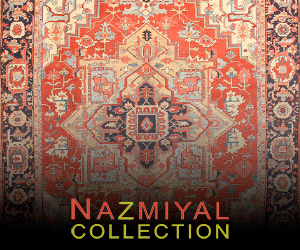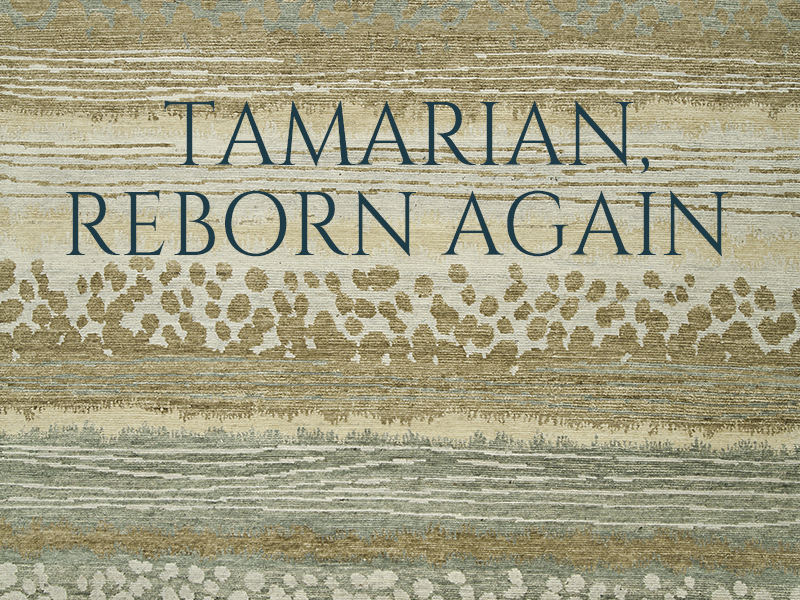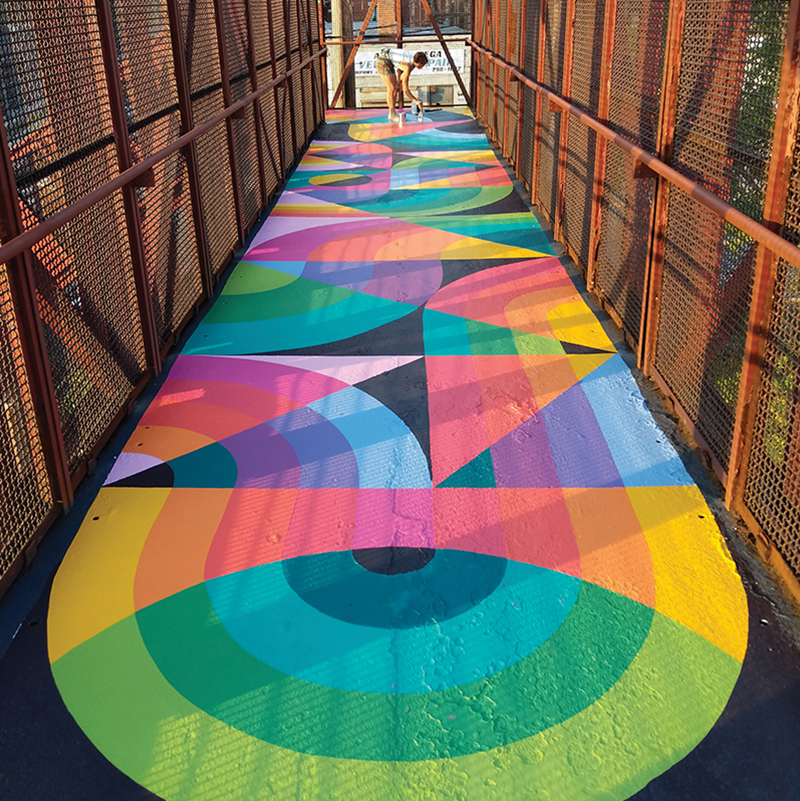Tamarian is a well-known name among those who frequent markets in Atlanta and High Point, and has likewise been a fixture at events such as The Rug Show for decades. For those who purchase rugs and carpets at retail however, the name may be unknown. Rug Insider takes a look at the firm and its staff as they embark on a new journey of creativity (and branding) under the guidance of firm Principal, and now sole owner, Ryan Higgins.
Within the rug and carpet trade the name Tamarian—correctly pronounced with a long second “a,” think “are” not “air”—is synonymous with quality carpets, fashionable timeless design, and as will become apparent throughout this article, superior and honest service. Outside the esoteric world of rugs and carpets however, it is a name perhaps not widely known. This is partly due to the firm’s conscious effort to “refrain from branding,” according to Tamarian Head of Sales Chris Saliga. “Our [brand] weakness has been one of our greatest strengths as it allowed us to grant our dealers exclusivity and geographic territory,” Saliga explains in reply to being asked about the firm’s strengths and weaknesses. “This year we are dedicated to getting creative to grow our Tamarian brand without compromising our commitment to our partners.”
Ned Baker, self-described “Marketing Generalist” of the firm, clarifies further: “We started the year with new leadership and took the moment to strengthen our core values and restate our commitments to being the best at what we do. There is a shared vision, and the entire staff has dedicated themselves to elevating their respective departments. I am heading our marketing efforts with the goal of supporting our products and dealers with engaging and meaningful content that helps people connect with our rugs. We have so many great designs to celebrate, so much good information to share, and an endless parade of colorful personalities to inspire and teach. It’s really exciting to spearhead this storytelling.”
Wait, what? New leadership? It seems we’ve entered the story late into the first act.
In 1995, Ryan Higgins answered a help wanted advertisement in a local free newspaper. Then owner of Tamarian Steve Cibor was searching for an “entry level artist” and the young, approximately nineteen-year-old Higgins came calling—literally becoming the first employee of the fledgling carpet house. “The partnering process began in 2011 and by 2018 I was vested,” Higgins says. “The impetus to become sole owner was part of a long-discussed plan. Soon after 2018, I had reached a point in my career where I was comfortable but needed to either grow or change in some way. I felt the same was true for the company. So, we began to negotiate, and late last year finalized an agreement. Funny as it sounds, it actually went pretty much according to the plan we had discussed all along.”

Ryan Higgins, Principal
Favorite Tamarian rug and why? Rounton Grange.
“Despite my love for all things modern and new, this [William Morris design] stands the test of time.”
And so it is that in early 2020 Higgins became sole owner of Tamarian and immediately set out to re-familiarize himself with the firm’s clients by hitting the road and calling upon them in their own showrooms—all prior to Covid-19 related shutdowns. “I think people will be surprised to see how supportive Tamarian truly is,” begins Higgins. “As we pass through this phase, (Said both in reference to the transition of ownership and the Covid-19 pandemic.) I expect a blossoming that welcomes and engages not just our clients, but their clients as well, in an honest, supportive fashion. I think you will see us collaborate not just with artists, but with other companies as well.”
One such collaboration is the newly-introduced carpet design “Union Charcoal Flame” which graces the cover of this issue. “Jessie and Katey are locally based muralists who do extensive work around the country, as well as some international work,” Higgins illuminates. [See sidebar on page 39 for more information.] “I first became aware of their work driving down the highway. Their premiere design has been well received by the design community, and it represents an important step forward for future collaborations. I think by beginning to promote the artists connected to the rug, along with the weavers and everyone else in the process, it creates a more personal connection to the process.”
This latter point is again stressed by Tamarian Head of Operations Jesse Kohler, when also asked about the firm’s greatest strength. “Relationships. Starting with our manufacturers in Nepal, working through our internal staff, and ending with our clients. It runs full circle,” Kohler states before reiterating, “I just want to highlight how important our team in Nepal is. Our business is dependent on their abilities to operate and produce this wonderful product. Without them none of this is possible.”

Jesse Kohler, Operations
Favorite Tamarian rug and why? Decked PW James.
“As a wise man once told me, ‘dance with who brung ya’ and for me it is Decked PW James. I have always enjoyed the design movement and color balance in this piece.”
While you may or may not be familiar with Tamarian as a brand in and of itself, the truth remains they have been and are continuing to produce quality carpets with an attention to carpet design, not just design applied to carpet. “There is no separation in the rug itself from deep design to simple lines,” begins Higgins. “Rugs are functional first insomuch that the color and design must work with the construction and material. But no matter what way we tweak it, it is many other people’s efforts that go into creating a hand-crafted object that provides comfort underfoot,” concludes Higgins before Baker adds specifics. “I love the Phoenix weave overall—the simplicity of the all-wool, textured knot but SO MUCH PERSONALITY! [emphasis Baker’s] They seem like ‘real rugs’ to me. Timeless. Functional. Beautiful. Interesting.”
Perhaps unbeknownst to some of the staff of Tamarian who praise the efforts of their Kathmandu, Nepal-based manufacturer, this author has first-hand knowledge of said manufactory owing to his personal involvement with the Nepal Carpet Manufacturers and Exporters Association (NCMEA). Having both toured their facilities and dined on multiple occasions with the owner thereof, I offer only two points of further clarification. Firstly, the facilities and processes used to produce Tamarian’s carpets are among a scant handful I would say are both world class and match the descriptions used in marketing and advertising; you get what Tamarian says you are getting. And secondly, there is a profound commitment to the craft of modern carpetry; Tamarian makes “real rugs” just as Baker asserts.
Designing and making a carpet however, only gets you so far and so attention turns once again to Saliga who spells out Tamarian’s approach to working with its sales partners to complete the process. “Every trade partner or retailer has different needs based on their market. We have always been approachable and are ready to help create tailor-made plans based on these needs. Aside from exchanging rugs to limit 'dead inventory,' we manage accounts using our detailed reporting system to let them know what is working for them and what is turning, and then consigning rugs to replace quick turns along with recommending what is working elsewhere that they are missing.” Saliga expounds further, “We’re also constantly booked doing designer events for our clients to educate and humanize our hand-crafted process. Our rugs are shipped, packaged, and labeled with care, but the end user doesn’t always understand how many hands touched their rug and the care and love that was put into it. This is really important to relay as it is one of the components of the value of a handcrafted, hand-knotted Tibetan rug.”
Geoff Duckworth is in charge of product at Tamarian, working closely with Higgins as the firm develops new designs and tailors solutions to the various custom rug projects which comprise just under half of the firm’s sales. “A lot of my time is split between managing/working on important custom projects and then also design development. My typical day consists of equal parts of these two major responsibilities,” begins Duckworth. “With the custom aspect, it is keeping my customers happy with CAD requests, processing orders and keeping them up to date on the status of their orders. With custom, there is a lot of problem solving and coming up with creative ideas for the project to get the end customer exactly what they want. My customers have come to rely on my expertise, experience, and guidance when working on their clients’ important projects. On the other hand, with design development, it is a lot of meeting and collaboration with Ryan. He is a great mentor and artist, which makes my job very enjoyable. We go through a process of design, which can range from purchased designs to a full-on original design from Ryan or other staff.” It is worth interjecting here a latter point made by Duckworth, “Tamarian is my creative family. The thing I love the most is that everyone has the freedom and opportunity to express their creativity.” For Duckworth, this means excelling in the coloration of new designs or custom projects. “Coloring and color placement is where I think my strongest contribution is leant to this process,” states Duckworth.

Geoff Duckworth, Product
Favorite Tamarian rug and why? String Theory Gray Charcoal.
“I get caught up in the layers and atmosphere as if you’re getting a glimpse into a mysterious fractal dimension.”
All of this is fine and well and was all either in place or in the works prior the outbreak of the Covid-19 pandemic and its resulting economic disruptions. As such it seemed only prudent to inquire further as to what efforts, if any, have changed in light of current circumstances. Higgins begins, “We are bringing on additional sales staff (including familiar faces, welcome back Fred Lomax!), improving our website and tech, and improving our physical spaces in order to host meaningful client events. All while trying to stay as lean as possible.” Saliga expands further, “No one knows just how hard the current situation will impact our industry but I am a firm believer that beautiful hand-crafted rugs need to be touched.

Chris Saliga, Sales
Favorite Tamarian rug and why? String Theory Blue Green.
“The one that just went out the door! But seriously, String Theory Blue Green. It marries the perfect mix of blues saturated with pure green and hints of gold.”
Consider younger designers who are used to shopping by digital images alone. They are far more likely to take a sample out to their client’s house than a full-size rug even when it is available in the showroom they’re working with! You can’t buy all full-size rugs and there are always some sexy fashion-forward designs that are loved but you are not sure you can sell. What better way to minimize the risk than bringing in a sample to survey your designer base at a fraction of the cost [and space]?,” concludes Saliga, rhetorically.
In what is perhaps a late second act analysis of this particular story of Tamarian, it seems the firm is well positioned to tackle any obstacle due to both the capable team, and the almost spiritual guidance of Higgins, who summarized his approach to tackling adverse times such as these with the phrase, “Through adversity, to the stars.”
As the curtain opens on the final act, we return to Baker who highlights some of the efforts underway to both increase Tamarian’s branding as Saliga first noted, as well as to adapt to the needs of this era. Baker explains, “We launched new social media accounts under the moniker @tamariansocial on all platforms as well as a Wordpress blog and Spotify Playlist. [Editor’s note: Tamarian can also be found on their original social media accounts @tamariancarpets.] We also started a podcast “Ned Talks” where I interview various personalities around the Tamarian universe on a range of rug-related topics. That’s an entirely new platform for us and it’s been exciting to explore and connect with our network in a direct, meaningful way.” Baker then further elaborates, “Our approach is to have a cohesive thread to the content we show across all platforms as well as an overall “narrative” to the flow. Ultimately you want that thread to lead to our dealer network promoting physical product, which becomes a much more measurable result of your posts. To that end, we hope to harness our dealers’ efforts online and offer support with content, campaigns, and promotions to sync our messaging and lead interested audiences to physical product.” Acknowledging the sometimes superfluous nature of marketing and advertising, Baker then concludes, “Marketing speak aside, we also want to keep the fun in the rug universe and celebrate the people and creativity that are the heart and soul of what we do. If our content comes from our genuine voice, it should have a unique quality that captures the right audience.”
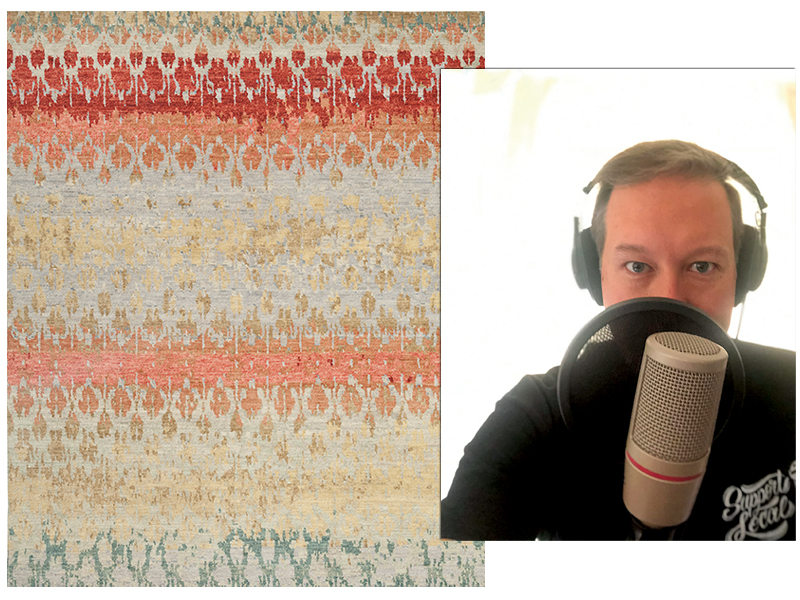
Ned Baker, Marketing
Favorite Tamarian rug and why? Irezumi PW Discus.
“It sports a gorgeous unexpected palette of corals, yellows, greens and neutrals that I have seen numerous times stop people in their tracks.”
Yet unstated in Baker’s assessment is the shifting nature of retail wherein experience often supplants sales in the initial interaction between clients and purveyor. “Retailers should promote their best pieces, anything they’re excited about themselves, and connect anyone who may be interested in that experience,” begins Baker. “A rug showroom is still a mystifying place to most people—a curiosity. Retailers should try to embrace this and offer an experience to the uninitiated that isn’t necessarily about ‘selling.’ Once you have a person physically in your space, they will undoubtedly see the luxury rug and be drawn to it.”
Extrapolating a theme from all of these various thoughts is no easy task, and for each reader the take-away may indeed vary to a degree. As such we conclude with thoughts from Higgins who espouses the core principles of Tamarian. “Making beautiful rugs, making clients happy, being available to serve… . Those principles are our guides on the trail.”
@tamariancarpets
@tamariansocial
tamarian.com
|
Jessie Unterhalter and Katey Truhn are a Baltimore-based artist team striving to transform public spaces into colorful and vibrant experiences.
|

